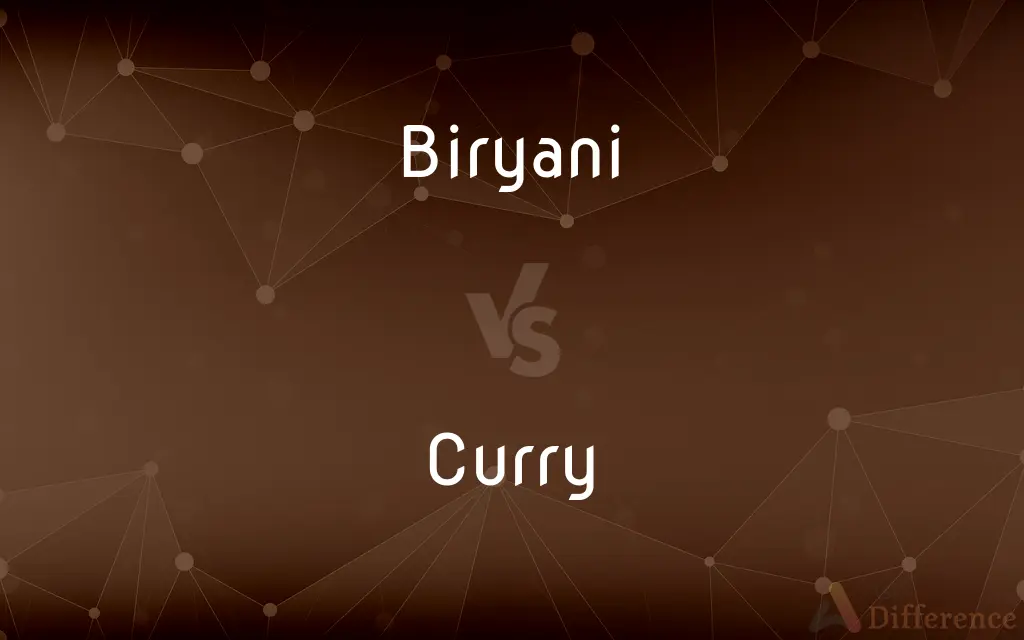Biryani vs. Curry — What's the Difference?
Edited by Tayyaba Rehman — By Fiza Rafique — Updated on April 2, 2024
Biryani is a flavorful rice dish with spices and meat, known for its layers, while curry is a gravy-based dish with a blend of spices and can include meat or vegetables.

Difference Between Biryani and Curry
Table of Contents
ADVERTISEMENT
Key Differences
Biryani is a one-pot dish, originally from South Asia, characterized by its aromatic spices, herbs, and the layering of rice with meat or vegetables. The preparation involves cooking the meat and rice separately before layering them together, allowing the flavors to meld during a final phase of cooking. It's celebrated for its complexity in flavors, often including cardamom, saffron, and turmeric, which give it a distinct taste and aroma. Curry, on the other hand, refers to a wide range of dishes that are cooked in a sauce seasoned with a complex combination of spices and herbs. It can include meat, fish, poultry, or vegetables and is known for its versatility in terms of spiciness, ranging from mild to extremely hot.
Biryani variations are numerous, with each region in South Asia offering its own unique take based on local ingredients and traditions. The term "curry" is used more broadly outside South Asia to describe almost any spicy, gravy-based dish. Its flavor base typically comes from a blend of ground spices, known as curry powder or paste, which might include turmeric, cumin, coriander, ginger, and chili.
While biryani is primarily a rice dish that might be served with a side of gravy or raita (a yogurt-based condiment), curry is more about the sauce and can be served with a variety of side dishes, including rice, naan, or other bread. The distinction between the two lies in their method of preparation and the role of rice in the dish. Biryani's unique feature is the layering of partially cooked rice with the meat or vegetables, which is then finished together, allowing the rice to absorb the flavors. Curry dishes vary widely by region, and the term encompasses a broad range of gravy-based preparations. From the coconut milk-based curries of South India to the creamy, tomato-based gravies of North Indian cuisine, the diversity of curry is vast. In contrast, while biryani also has regional variations, it remains distinctively a rice dish, with differences mainly in the types of spices used and the method of layering and cooking.
In terms of ingredients, both dishes can be very similar, using a base of spices, garlic, ginger, and onions. However, the specific spices and their proportions vary greatly, contributing to each dish's unique flavor profile. Additionally, while yogurt is often used in the marinade for biryani to tenderize the meat and add a subtle tanginess, curries might use yogurt, cream, coconut milk, or tomato as the base for their gravy.
Comparison Chart
Base
Rice
Gravy
ADVERTISEMENT
Main Ingredients
Rice, meat (or vegetables), spices
Meat, vegetables, spices, gravy base
Origin
South Asia
Varied, widely associated with South Asia
Serving
As a main dish, sometimes with gravy or raita on the side
Often served with rice, bread like naan or roti
Spice Level
Fixed in the dish, varies by recipe
Can often be adjusted according to taste
Compare with Definitions
Biryani
Known for its aromatic spices and saffron-infused rice.
The aroma of the biryani, filled with saffron and cloves, wafted through the house.
Curry
The term can refer to a variety of dishes across different cultures.
Japanese curry is thicker and sweeter compared to its Indian counterpart.
Biryani
A South Asian rice dish featuring layers of rice, spices, and meat or vegetables.
Chicken biryani is a popular dish for festive occasions.
Curry
Served as a part of a meal, usually accompanied by rice or bread.
For dinner, they had a vegetable curry served alongside freshly baked naan.
Biryani
Each region has its own version, reflecting local tastes and ingredients.
Hyderabadi biryani is spicier and uses basmati rice, distinguishing it from other types.
Curry
A dish of meat, vegetables, etc., cooked in an Indian-style sauce of strong spices and turmeric.
She served a mild chicken curry with basmati rice.
Biryani
Served as a main course, often accompanied by sauces like raita.
For dinner, they had mutton biryani with a side of cucumber raita.
Curry
Spice level can range from mild to very hot, depending on the type.
The vindaloo curry was so hot, it brought tears to their eyes.
Biryani
Involves a cooking technique where rice and meat are cooked separately then layered.
The chef meticulously layered the cooked lamb over the rice to prepare the biryani.
Curry
Often includes a liquid base, such as coconut milk or tomato sauce.
The fish curry had a rich coconut milk base, making it creamy and flavorful.
Biryani
Biryani () is a mixed rice dish originating among the Muslims of the Indian subcontinent. It is made with Indian spices, rice, and meat usually that of chicken, goat, lamb, prawn, fish, and sometimes, in addition, eggs or vegetables such as potatoes in certain regional varieties.Biryani is popular throughout the Indian subcontinent, as well as among the diaspora from the region.
Curry
Curry is a variety of dishes originating in the Indian subcontinent. It uses a combination of spices or herbs, usually including ground turmeric, cumin, coriander, ginger, and fresh or dried chilies.
Biryani
A South Asian dish containing meat, fish, or vegetables and rice flavored with saffron or turmeric and other spices.
Curry
To groom (a horse) with a currycomb.
Biryani
A spiced dish of rice, blended with meat and/or vegetables.
Curry
To prepare (tanned hides) for use, as by soaking or coloring.
Curry
To season (food) with curry.
Curry
A dish of meat or vegetables flavored with pungent spices, typical of South Asian and Southeast Asian cuisines.
Curry
A blend of spices used in or suggesting the flavor of curry, typically containing turmeric, cumin, coriander, and ginger, among other ingredients.
Curry
Curry powder.
Curry
One of a family of dishes originating from Indian cuisine, flavoured by a spiced sauce.
Curry
A spiced sauce or relish, especially one flavoured with curry powder.
Curry
Curry powder.
Curry
(transitive) To cook or season with curry powder.
Curry
(transitive) To groom (a horse); to dress or rub down a horse with a curry comb.
Curry
(transitive) To dress (leather) after it is tanned by beating, rubbing, scraping and colouring.
Curry
(transitive) To beat, thrash; to drub.
Curry
(transitive) To try to win or gain (favour) by flattering.
Curry
To perform currying upon.
Curry
To scurry; to ride or run hastily
Curry
To cover (a distance); (of a projectile) to traverse (its range).
Curry
To hurry.
Curry
To dress or prepare for use by a process of scraping, cleansing, beating, smoothing, and coloring; - said of leather.
Curry
To dress the hair or coat of (a horse, ox, or the like) with a currycomb and brush; to comb, as a horse, in order to make clean.
Your short horse is soon curried.
Curry
To beat or bruise; to drub; - said of persons.
I have seen him curry a fellow's carcass handsomely.
Curry
To flavor or cook with curry.
Curry
A kind of sauce much used in India, containing garlic, pepper, ginger, and other strong spices.
Curry
A stew of fowl, fish, or game, cooked with curry.
Curry
(East Indian cookery) a pungent dish of vegetables or meats flavored with curry powder and usually eaten with rice
Curry
Season with a mixture of spices; typical of Indian cooking
Curry
Treat by incorporating fat;
Curry tanned leather
Curry
Give a neat appearance to;
Groom the dogs
Dress the horses
Common Curiosities
Can curry be made without coconut milk?
Yes, there are many types of curry that do not use coconut milk, instead relying on tomato, yogurt, or cream for the base.
Is biryani eaten with any side dishes?
It's often served with raita, a yogurt-based sauce, or sometimes a side of curry gravy to add moisture and flavor.
What's the main difference between biryani and curry?
Biryani is a rice-based dish with spices and meat or vegetables, often layered, while curry is a gravy-based dish that can be served with rice or bread.
Can both biryani and curry be vegetarian?
Yes, both can be made in vegetarian versions, substituting meat with vegetables or legumes.
Is biryani considered spicy?
The spice level of biryani can vary greatly, but it generally has a balanced flavor that is not overwhelmingly hot.
What makes curry yellow?
The yellow color in many curries comes from turmeric, a key spice in curry powder blends.
Do all curries taste the same?
No, the taste of curry can vary widely depending on the regional recipe, type of curry, and the blend of spices used.
Is it true that biryani is a complete meal in itself?
Yes, biryani is considered a complete meal, providing a balanced mix of rice, protein, and spices.
How long does it take to make biryani?
The preparation and cooking time for biryani can vary, but it typically takes a couple of hours, given the complex layering and cooking process.
What's the best way to serve curry?
Curry is best served hot, accompanied by rice, naan, or other types of bread to soak up the sauce.
Is biryani spicy or flavorful?
Biryani is known for being both spicy and flavorful, with a complex blend of spices that provides depth without necessarily being hot.
What is a common ingredient in both biryani and curry?
Common ingredients include spices such as turmeric, cumin, and coriander, as well as garlic and ginger.
Are there different types of curry powder?
Yes, there are various blends of curry powder, each with a different combination of spices, tailored to different dishes and regional tastes.
Can I use any type of rice for biryani?
Basmati rice is traditionally used for its fragrance and long grains, but other types can be used depending on personal preference or regional variations.
How do I choose between biryani and curry?
Your choice might depend on whether you're in the mood for a rice dish or a sauce-based dish and your preference for spice levels and ingredients.
Share Your Discovery

Previous Comparison
Pleomorphism vs. Polymorphism
Next Comparison
Whitemail vs. BlackmailAuthor Spotlight
Written by
Fiza RafiqueFiza Rafique is a skilled content writer at AskDifference.com, where she meticulously refines and enhances written pieces. Drawing from her vast editorial expertise, Fiza ensures clarity, accuracy, and precision in every article. Passionate about language, she continually seeks to elevate the quality of content for readers worldwide.
Edited by
Tayyaba RehmanTayyaba Rehman is a distinguished writer, currently serving as a primary contributor to askdifference.com. As a researcher in semantics and etymology, Tayyaba's passion for the complexity of languages and their distinctions has found a perfect home on the platform. Tayyaba delves into the intricacies of language, distinguishing between commonly confused words and phrases, thereby providing clarity for readers worldwide.
















































